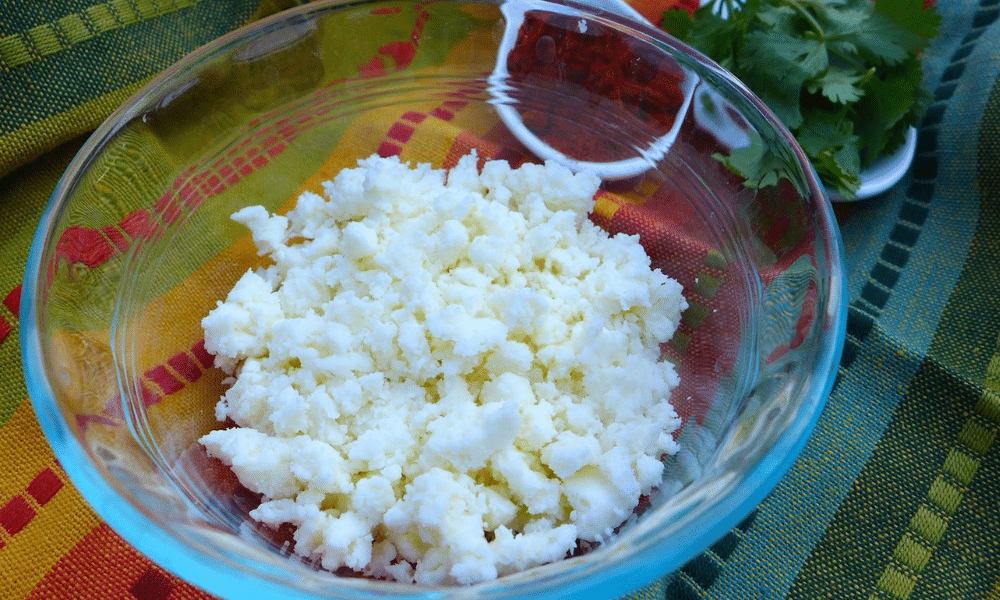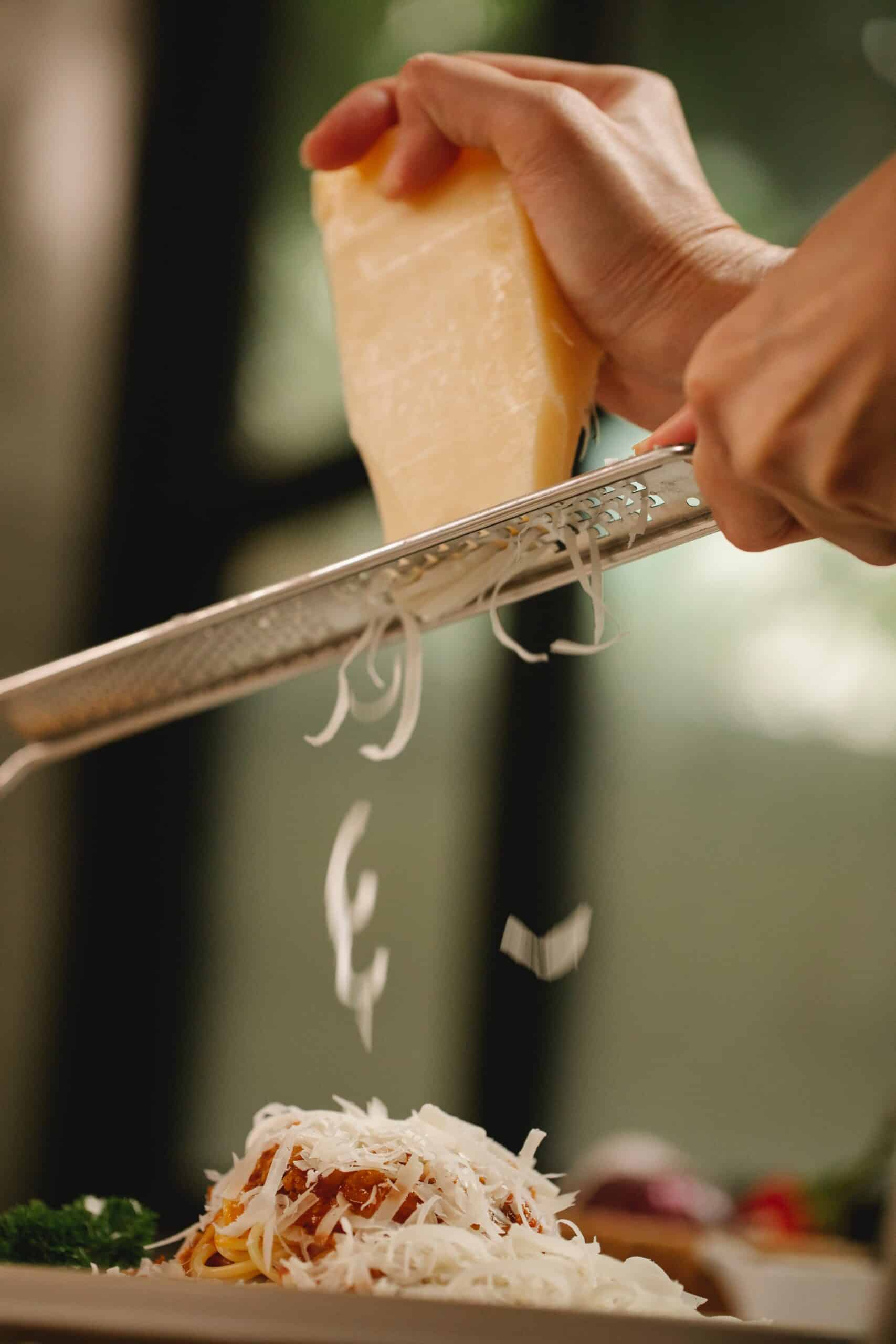Updated on November 11th, 2022
Cotija cheese is a Mexican cheese that comes in a block form and is most commonly served grating. It has a milky, firm texture similar to Parmesan, and its creamy, milky flavour adds an exciting twist to any dish. It’s also known for being a popular topping for nachos and chilli. This mild yet distinctive cheese can be found on the menu of your favourite Mexican restaurant or in your local grocery store.
Cotija cheese is best enjoyed with spicy meals, such as enchiladas. Its mild flavour pairs well with many foods, including fruit and vegetables. Grated finely, it clings to food. Moreover, it’s an excellent topping for a wide variety of dishes. If you love cheesy toppings, consider trying cotija!
What is Cotija Cheese?
Cotija is a type of cheese that originated in the Mexican town of Cotija. Because cotija is made by hand, each batch has a slightly different flavour and texture. It’s a crumbly white cheese with a firm, dry texture. Cotija is commonly found in blocks, but it can also be grated. The texture and flavour of the cheese vary depending on whether it is fresh or aged. Fresh cotija has a texture similar to feta cheese, while aged cotija has a texture similar to parmesan.
Cotija cheese has a tangy, pungent flavour. The salt content makes it a versatile substitute for parmesan cheese. Its salty flavour complements many other ingredients and enhances the taste of other foods. Its creamy sour taste also makes it an excellent topping for a burger. The aneho variety has a more funky and sour flavour.
In Mexico, cotija is a complex, white, crumbly cheese often served as a topping. It doesn’t melt and is therefore suitable for vegan and vegetarian recipes. Traditionally, it is served with meats or vegetables, and however, it’s also used in soups and can be added to various foods. Unlike mozzarella, cotija is made of cow’s milk.
What Does Cotija Cheese Taste Like?
The flavour of Cotija cheese is similar to that of feta cheese: bold, tangy, and salty. Cotija that is younger can be crumbled or chopped up to add a unique flavour to a dish, whereas older cotija is better for grating. It isn’t creamy cheese at all, and it has a chewy texture and a heartier, fluffier texture.
This savoury cheese has a salty-yet-milky flavour profile that varies depending on how long it has been aged. According to Bon Appetit, a younger (younger) Cotija cheese has a feta-like texture. On the other hand, Cotija develops a sharper, firmer flavour profile and texture, similar to Parmesan.
Its taste is best experienced by tasting it fresh. In contrast to aged cheese, fresh cotija has a robust and nutty flavour. It is best served with tacos, tortillas, and fresh corn. Alternatively, cotija can be used as a topping for other dishes. But if you can’t find cotija in your area, you can always buy a low-fat version at your local grocery store.
What are the Nutritional Benefits of Cotija Cheese?
Cotija cheese is a unique Southern Central American delight with many nutritional benefits. It’s also great for snacking on.
- Cotija cheese is a high-protein cheese made from cow and goat milk.
- Calcium, vitamin A, and vitamin D are also abundant.
- Protein, calcium, potassium, and vitamin A are all found in this cheese.
- Per 100 grams, Cotija cheese contains more than 30% of the daily value (DV) for calcium and magnesium.
- It also has higher phosphorus and vitamins like riboflavin, folate, B12, thiamine, and niacin.
- So you don’t have too much on your plate, rinse before removing excess salt from the aging process to reduce the high sodium level.
- This hard Mexican cow’s milk cheese may not have many health benefits, but it does.
- Cotija cheese is high in protein, making it a good option for satisfying hunger.
- It’s also high in calcium and vitamin D, which contribute to strong and healthy bones.
- Cotija cheese has a lot of calories (100 per serving), but it’s worth it when you’re craving something salty or savoury.
What Goes into Making Cotija Cheese?
Cotija is made from cow’s milk and goes through the typical acidification (via lactic acid bacteria) and rennet coagulation processes to become a curd.
Cut, drain, and press the curd into a mould. The moulded wheel is then soaked in brine for several days, giving it the salty flavour that has made cotija famous. Finally, the brined cheese must be aged.
Fresh cotija can be aged for two or three weeks (though 100 days is more common), whereas aged cotija requires at least a year to mature.
Some cotija is still made with raw milk; if this is a concern, read the labels carefully when purchasing fresh cotija.
What’s the Best Way to Eat Cotija?
Cotija is rarely the star of a dish, preferring instead to complement the flavours of other savoury ingredients. It’s primarily used as a garnish, and it can be grated or crumbled over a variety of dishes.
Cotija is a popular topping for tacos, enchiladas, and elote, a popular street dish made with corn on the cob, mayonnaise, and Tajin seasoning. It goes well with guacamole, spicy peppers, chicken, steak, seafood, or vegetables in soups and salads.
You also don’t have to limit yourself to Mexican cuisine. Try it as a burger topping, a pasta topping, or a pizza with its old pal corn.
Unfortunately, because cotija contains animal rennet, it is not suitable for vegetarians. Feta is a good choice if you want a fresh, salty cheese for a vegetarian recipe.
How to Locate and Select Cotija Cheese?
The first step in locating and selecting Cotija cheese is to understand the various types of Cotija cheese.
- Fresh and aged are the two main varieties that differ in flavour, size, and texture.
- Enchiladas, tacos, and salads all benefit from fresh Cotija cheese.
- Cotija is a crumbly cheese with a saltier flavour than other cheeses like Feta or Romano.
- On the other hand, Aged Cotija can add flavour to dishes like quiche and certain pastries without adding moisture, making your dish soggy.
- The following step is to learn how to read the label.
- A producer’s name, weight, country of origin, and freshness date will be printed on Cotija cheese.
- You want to find products that are both fresh and flavorful.
- Finally, let’s look at where you can purchase Cotija cheese.
- It can be found in most supermarkets and specialty shops that sell Mexican or Latin American foods, such as Mexican grocery stores.
- If they don’t have what you’re looking for, ask them to order it.
How do you Keep Cotija Cheese Fresh?
Cotija cheese can be kept for up to two weeks in the refrigerator. If you use cotija frequently, you may want to store a smaller amount to not spoil before being consumed. It’s best kept in cool and dark places, and it’s not recommended to consume it raw. A few teaspoons of Cotija per serving can enhance the flavour of a dish.
You could also freeze your Cotija cheese and use it as needed or thaw it out. Cotija cheese can be frozen for up to a year, but it should not be thawed and frozen again. Before storing Cotija cheese in the refrigerator or freezer, some people wrap it tightly in aluminum foil or vacuum seal it. Cotija cheese should not be stored in direct sunlight or at high temperatures.
What is the Difference Between Cotija Cheese and Feta Cheese?
- Cotija is a Mexican cheese named after the Michoacán town of Cotija. Its Mexican origins may be difficult to discern because it tastes almost identical to Parmesan. Feta originates in Greece, where ‘Feta’ means slice.’ Its Mediterranean flavours make it simple to pinpoint its origins.
- Cotija is distinguished from Feta by the milk used in its production. While Cotija is made with cow and/or goat milk, Feta is made with either pure sheep’s milk or a 70:30 blend of sheep and goat milk.
- Cotija is aged from three to twelve months. When it comes to this type of cheese, there are two options. Tajo is aged for a shorter time, while Cotija de Montana can last for a year. Feta cheese is perishable, and the cheese can be aged for three months if it is not opened. However, the product is suitable for 4 to 7 days once opened.
- The texture of Cotija cheese varies depending on its age. Tajo has a soft, crumbly texture due to its youth. Due to its age, Cotija de Montana has a dry, complex, and grainy texture. Because Feta is cured and sold in brine, it has a higher moisture content than Cotija. As it ages, the texture can shift from soft to slightly hard.
- Cotija has a saltier flavor than Feta. Eating the cheese on its own will give you milky notes, and there may also be fruity and buttery undertones. The flavour of the cheese can become sharper as it ages, and it’s a little tangy and mostly nutty.
- Feta is always a tangy cheese, whether young or old. And, like the other, the flavour becomes sharper and tangier over time, and Feta cheese can have a slight citrus aftertaste.
Cotija Cheese Applications
Cotija cheese can be used in a variety of dishes. It has a slightly nutty flavour that is reminiscent of Parmesan. I’ve already stated that I enjoy using it as a garnish. This is another cheese that allows you to express yourself. Here are some additional suggestions and recipes:
Carnitas pulled pork enchiladas as a filling
Chilaquiles Verdes, shrimp fajitas, refried bean dip, or Mexican lasagna as a topping
Cactus salad with grilled nopales or Mexican salad in a salad
Cotija is best used as a garnish or topping, as you can see. This is primarily due to its inability to melt.
It’s used in various Mexican dishes, including tacos, burritos, and queso fresco. The most common way to use it is in a recipe, and it’s also easier to find.
Can we Substitute Cotija Cheese?
If you’re not a fan of the cheese you’re eating, you can easily substitute it with another cheese. Instead of cotija, you can use Parmesan or Romano cheese in recipes. In addition to shredded chicken salad, cotija cheese is also used to make quesadillas, a Mexican snack. But these substitutes are not as popular as cotija.
If you’re looking for a vegetarian or vegan version of cotija cheese, you can use alternatives. These substitutes vary according to whether the cheese is fresh or aged, and it tastes saltier than aged cheese if it is fresh cheese. Trader Joe’s sells lower-fat versions of this famous cheese. But if you want a substitute with an acidic flavour, try Mexican queso fresco.
There are many substitutes for this versatile cheese, and just be sure to check the dish’s ingredients first.
Conclusion
It’s best to add cotija to Mexican dishes. It’s an excellent topping for elote, and corn on the cob dish. It’s also great on burgers and chilis. It’s an excellent addition to any Mexican meal! It’s a delicious, versatile cheese full of flavour and protein. So, if you’re not familiar with it, get a little more familiar with it!
If you’re looking for cotija cheese, you’ll find it in Mexican markets and regular grocery stores, and it’s also readily available in regular grocery stores. If you can’t find the cheese you’re looking for, you can try feta. It’s a delicious substitute for a slice of younger, softer cotija cheese, and its milky flavour makes it a good substitute for vegetarian dishes.

